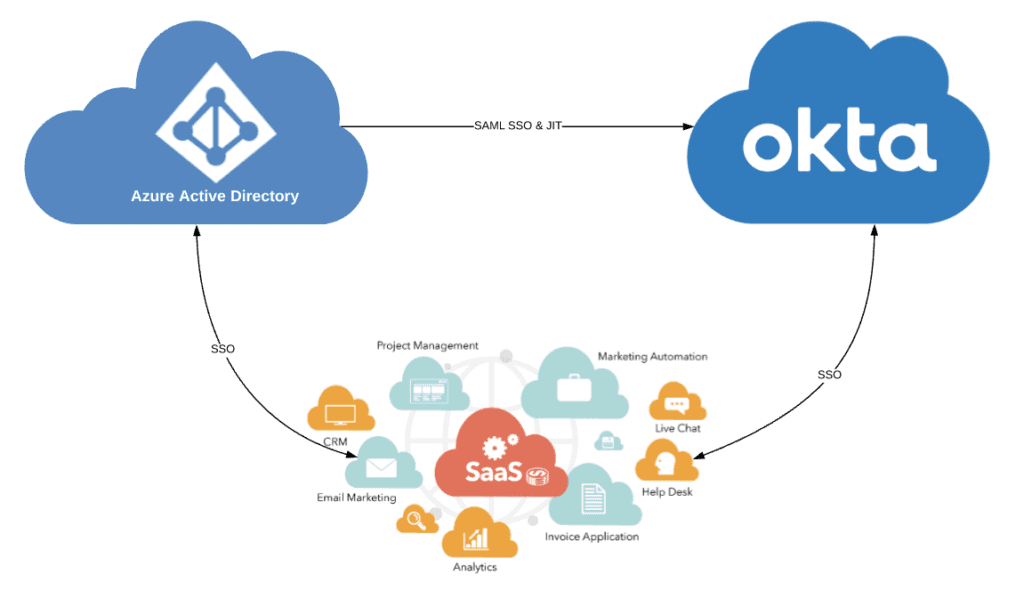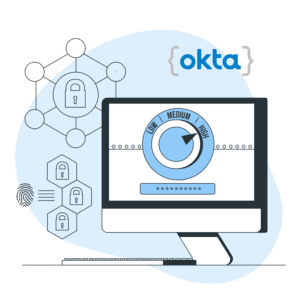
Our team gets asked frequently, “Which cloud-based Identity and Access Management solution does BlueFletch see used most often?” And our answer is Microsoft Azure Active Directory and Okta. While Azure AD has been around longer, Okta has made significant strides that have positioned them as the current market leader.
Let’s see how enterprises can improve the security of their company-owned devices by using Okta and single sign-on. Check out our Enterprise SSO guide here!
Okta Identity Service
Okta is a cloud-based identity service centered on seamless integration and delivering secure authentication, security, and efficiency to large-scale businesses. Their core products and add-ons are focused on improving workforce customer identity with single sign-on, MFA, and user management. These solutions are for organizations adopting and building for cloud and mobile that need to contain costs, fulfill user productivity targets, and avoid security risks.

IT can configure Okta via an admin console, while staff logging in with SSO into SaaS and internal apps can access Okta via an end-user portal.
While the BlueFletch Launcher integrates with and supports single sign-on across all major Identity Providers, we see Okta being used most frequently among our customers. Here are a few reasons why Okta is the leading provider.
- One Unified Identity Platform: Okta offers a single identity system of record for all types of users (such as employees, customers, contractors, etc.) and all types of resources such as infrastructure, apps, and APIs.
- Vendor and Platform Agnostic: Okta integrates all apps, regardless of the platform, with more than 6,500 pre-built integrations with cloud and on-prem systems. The Okta Integration Network is a key reason so many large enterprises are starting to standardize on the company’s identity platform.
- Frictionless Experience: For both IT admins and developers, Okta’s identity and access management products are highly streamlined for ease of use.
- Automated User Management: Okta’s user management features enable the service to automatically manage user accounts within applications, saving organizations time and money – while also ensuring correct access privileges are always up to date.
Single Sign-On: A Must-Have for your IT Admins, End Users, and Help Desk
Passwords are a double-edged sword; while they can protect sensitive data and systems, they are also easy to forget and time-consuming to type into each application. Scheduled password changes and having to enter credentials manually on a mobile device add additional wrinkles to this process.

Single sign-on (SSO) solves these issues by providing employees with a single point to log in and access all of their applications – while also allowing IT departments to manage user credentials securely.
In today’s enterprise mobility climate, single sign-on plays an integral role in efficient and secure Identity Access Management.
Here are a few ways a single sign-on solution solves common use-cases in enterprise scenarios:
1. End-User Login Experience
Use Case: An employee needs to access apps on their corporate device to complete tasks throughout their workday but experience bottlenecks with managing numerous passwords. By not being able to seamlessly log on to the apps they need at any time, user experience, adoption, and productivity suffer.
- Solution: In a single sign-on environment, users are only required to manage one set of credentials, which is a big win for most users. In addition to convenience, having a single point of authentication streamlines the day-to-day operations of your employees, allowing them to focus on more important tasks rather than wasting their time logging into multiple apps.

2. Help Desk Call Volume and Password Resets
Use Case: Your help desk receives on average 21 help desk calls per user each year. 50% of those calls are related to password resets, which can be an extremely time-consuming and costly task.
- Solution: With single sign-on, users don’t have to keep track of as many passwords. Companies that have implemented single sign-on will often see fewer help desk tickets for password resets. Consequently, implementing a single sign-on solution reduces non-productive tasks and delivers cost savings. While a reduction in help desk calls sounds insignificant, consider that several large enterprises are setting aside $1M each year for password resets.
3. Compliance and User Access Control
Use Case: Navigating and managing users, applications, policies, and devices across your environment is complex and cumbersome for your IT team to maintain. Especially when you factor in employees, contractors, and customers who have user-level permissions and security needs. The process for adding new users or removing them after they leave the company can be quite convoluted.
- Solution: With the right single sign-on solution, organizations can have peace of mind knowing the right people have appropriate and secure access to their business apps. Using SSO puts the control of authentication in one central location, making provisioning and de-provisioning easier to manage for your IT team.
Activating SSO for BlueFletch Enterprise Launcher
BlueFletch has worked to ensure Okta integrates well with BlueFletch Enterprise, specifically Launcher. Together, our products provide a more powerful, secure solution to support the needs of our customers. These integrations allow us to optimize for end-user experience and efficiency through single sign-on – while also giving IT admins a simple, quick integration process.
Lastly, the integration enables enterprises to leverage their existing investment in Okta’s Identity management platform rather than maintaining multiple identity systems.
If you are a current Okta customer and would like to see how simple it is to set up with BlueFletch Launcher, check out this explainer video below or contact us at info@bluefletch.com for more information.
